Display and Use the Default Activities Process Tree
You can manage the basic activities in the default display of the Activities Process Tree.
From any product: - Select .
A PPR context with an empty Machining Cell is created. An empty Activities Process Tree opens automatically.
- Create a generic machine or assign a machine from the database.
As soon as a machine is assigned to the Machining Cell, a Part Operation and a Manufacturing Program are created in the Activities Process Tree.
- Alternatively, open an existing Machining Process or PPR context .
 By default,
the
Activities Process Tree opens
automatically.
By default,
the
Activities Process Tree opens
automatically.
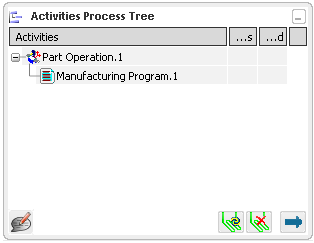
If machining activities already exist, the Activities Process Tree is populated with them.
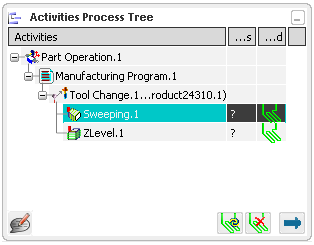
It contains the
following items:
- A tree viewer where
the activities are displayed. There are a maximum of four levels in the
tree:
- Part Operation,
- Manufacturing Program,
- Tool Change,
- Machining Operation.
- Two columns
displaying the status (green, orange, or red) and the computation
status (Computed/ Not computed).
- A toolbar.

If the Activities Process Tree does not appear automatically, select . Optional: Regarding the status: - To display automatically the current status of the Machining Operation, go to and select the Update activity status automatically check box.
- The question mark ? in the status column is replaced with status lights.
- When necessary, the masks ! (not complete) or
 (not up-to-date) appear on the activity icons. (not up-to-date) appear on the activity icons.Note:
only one status mask can be displayed on a given icon, the following status order being applied: inactive, locked, not complete, not up-to-date, video cgr.
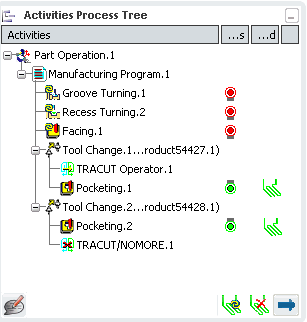
- Otherwise, right-click a question mark and select Display Status in the contextual menu.

The question mark is replaced by a status light.
Click Information  at the bottom of the Activities Process Tree and select an activity. at the bottom of the Activities Process Tree and select an activity. You can go from one activity to another while the information area is open. An additional area is displayed, with information about the selected activity.
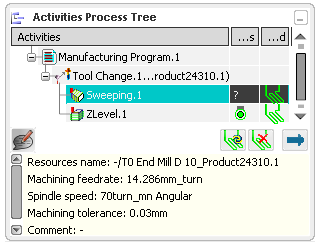
Click  to hide the information area. to hide the information area. Select an activity (Manufacturing Program Tool Change, or Machining Operation) and click Compute Tool Path  - Select the type of computation.

The tool paths under the selected activity are computed. Select an activity (Manufacturing Program, Tool Change, or Machining Operation) and click Remove Tool Path  The tool path is removed. Click - at the right top of the dialog box to minimize the Activities Process Tree. When minimized, the Activities Process Tree is iconized at the middle-right hand of the screen  . . Click  to restore the Activities Process Tree. to restore the Activities Process Tree.

Expand the Activities Process Tree
You can access more information by expanding the Activities Process Tree.
Click the blue arrow to expand the Activities Process Tree.

Create customized views of the Activities Process Tree.
- Click one of the view icons
 You can create up to 4 customized views. This bring you in a view (View 1, View 2, View 3 or View 4).
- Use the contextual menu of the columns header to customize the view.
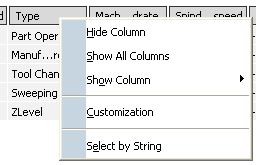
- When you select Show Column, select the column to display from the list:
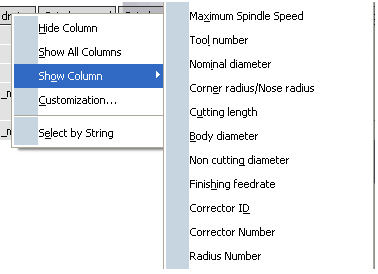
- When you select Customization, a new dialog box is displayed:
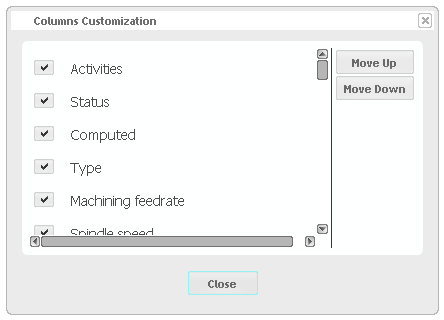
This is the panel for all immersives
actions with lists.
Check/Uncheck boxes to show/hide columns.
Select columns title and use the Move Up or Move Down buttons to change their order of
display. Multi-selection is supported.
- When you choose Select by String, enter the string (not case sensitive) to search in a given column in the field that appears:

This selects all the lines where an occurrence of the string has been found.
Up to four customized views can be defined and saved this way. You can then easily switch from one view to another one. The columns visibility is
managed by settings which save the last displayed columns. These
columns are automatically displayed next time you switch on
expanded view.
When the Automatic compute from tooling Feeds and Speeds check boxes in the Feed and Speeds tab are not selected (see About Feeds and Speeds), the feeds and speeds values and some other parameters can be edited from the Activities Process Tree: - Double-click the value of one operation you want to edit and enter the new value.
- To edit the parameters of several Machining Operations that are in the same column, select the lines of those Machining Operations, then right-click the parameter

and
- select Edit: you can type in the new value directly.
- or Advanced Edit: you can edit the parameter from the dialog box that is displayed:

The values are updated in the Activities Process Tree and in the Machining Operation dialog box.
|